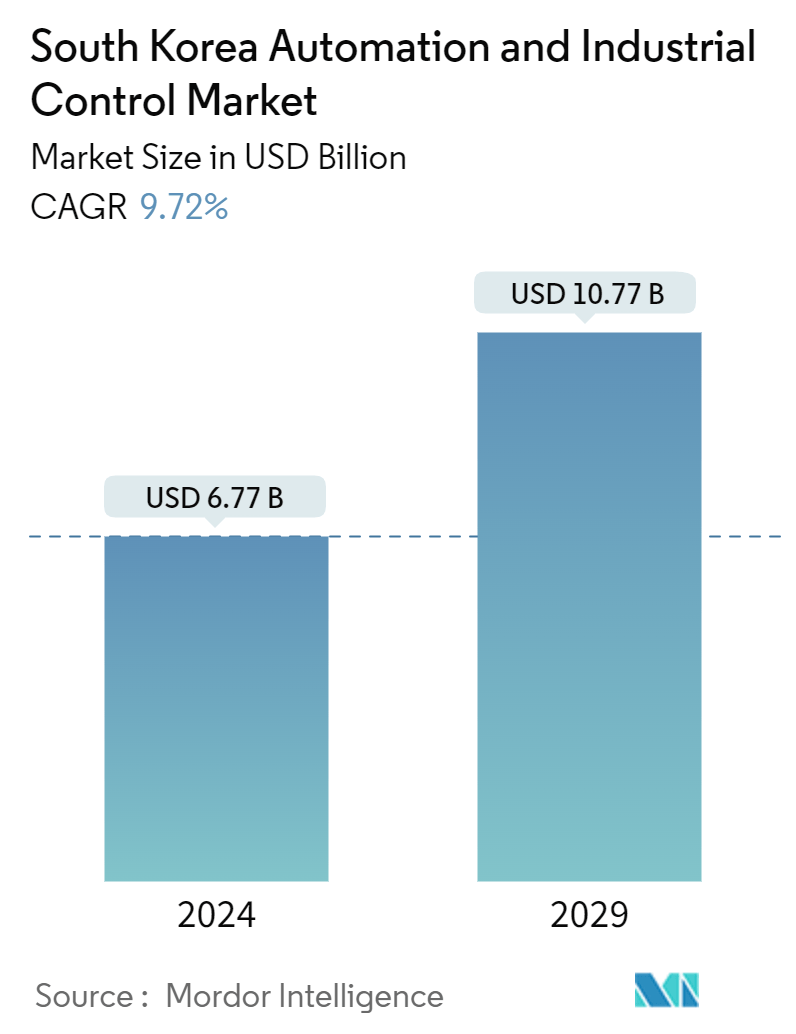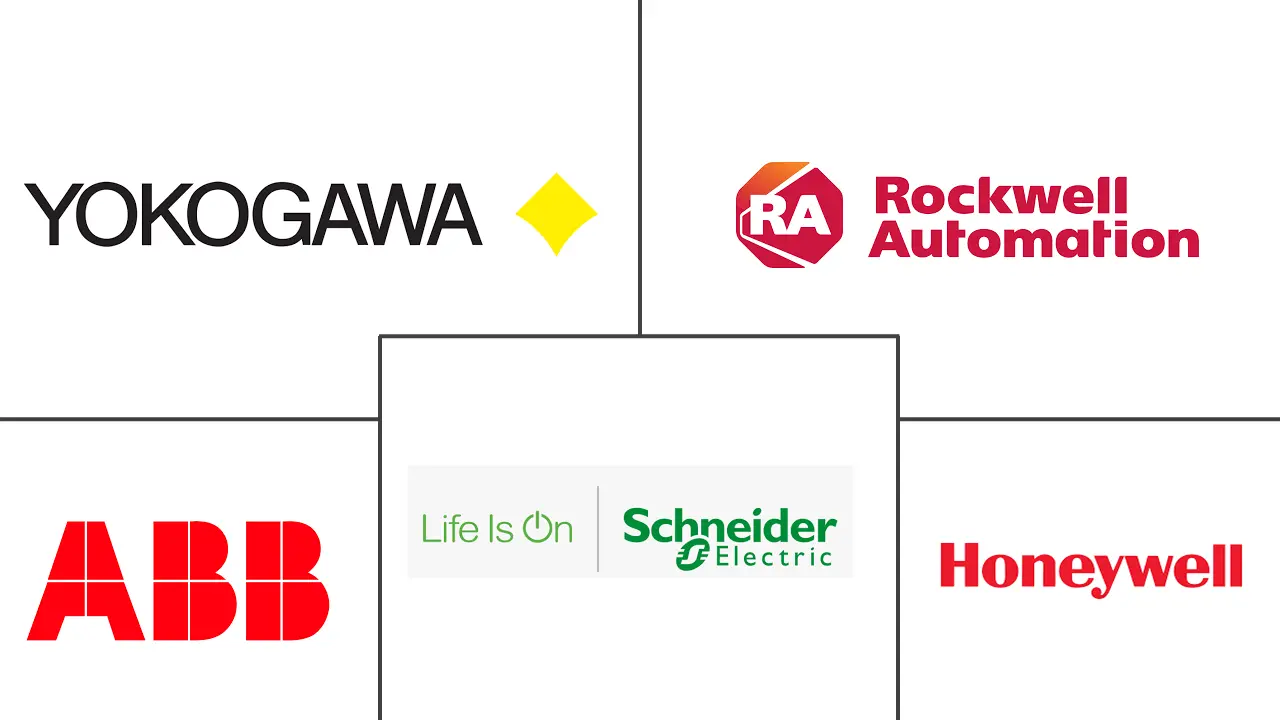Market Size of South Korea Automation And Industrial Control Industry

| Study Period | 2019 - 2029 |
| Base Year For Estimation | 2023 |
| Market Size (2024) | USD 6.77 Billion |
| Market Size (2029) | USD 10.77 Billion |
| CAGR (2024 - 2029) | 9.72 % |
| Market Concentration | Low |
Major Players
*Disclaimer: Major Players sorted in no particular order |
South Korea Automation and Industrial Control Market Analysis
The South Korea Automation And Industrial Control Market size is estimated at USD 6.77 billion in 2024, and is expected to reach USD 10.77 billion by 2029, growing at a CAGR of 9.72% during the forecast period (2024-2029).
Factory automation and control solutions facilitate the automation of manufacturing/production facilities by designing and building fully integrated intelligent control systems, including robots, sensors, industrial equipment, computers, and advanced data processing solutions.
- Some prominent factors driving the growth of the market include the inclination of manufacturers toward cost-efficient processes, growing demand for the adoption of the Internet of Things (IoT) and machine-to-machine technologies, and significant automation of manufacturing processes. Automation of manufacturing processes offers several benefits, such as effortless monitoring, waste reduction, and enhanced production speed. This technology offers customers enhanced quality standardization and reliable products within time and at a much lower cost.
- Connecting industrial machinery/equipment and obtaining real-time data have been key in adopting SCADA, HMI, PLC systems, and visualization software, thus enabling the reduction of faults in the product, decreasing downtime, scheduling maintenance, and switching from reactive to predictive and prescriptive stages for decision-making.
- Furthermore, the virtualization of automation control systems is a key trend observed in the market, also known as the thin layer between the virtual machine and the host server. The virtual machine contains the operating system and software. Different operating systems are operated on top of a primary operating system using virtual machines. Virtualization can be applied on layers in an industrial premise, such as servers, storage, desktops, files, and networks. It provides benefits such as optimum resource utilization and savings of operation and power costs.
- Moreover, industrial system architects, integrators, and machine builders have leveraged connected computing advances to help manufacturing facilities function more efficiently. The upsurge in the requirement for real-time intelligence, better control of operations and scheduling, and increasing market penetration of big data analytics in the manufacturing industry are anticipated to further generate the demand for advanced process automation technology during the forecast period.
- Big data analytics facilitates an enterprise to use factory automation to shift from reactionary practices to predictive ones, a change that targets to improve the efficiency of the process and performance of the product. The increasing need for the adoption of advanced technology is likely to augment the development of the market studied.
- Automation equipment requires high capital investment to invest in smart manufacturing (an automated system can cost millions of dollars to install, design, and fabricate). The cost of purchasing the equipment, including robotic systems, conveyor belts, sensors, and control systems, can be substantial. The factory automation equipment also necessitates the customization and integration into existing production systems.
- This process involves designing, engineering, and programming the equipment to meet specific manufacturing requirements. The complexity of customization and integration adds to the overall costs. Moreover, installing automation equipment may require modifications to the existing infrastructure of the factory. These high costs discourage factory operators from choosing high-end industrial robots, challenging the market's growth.
South Korea Automation and Industrial Control Industry Segmentation
Factory automation refers to the use of control systems, machinery, and computer systems to automate industrial processes and tasks, reducing the need for human intervention. This includes processes like manufacturing, material handling, and quality control. The industrial controls market encompasses the products and systems used to monitor and control various industrial processes. This includes components like programmable logic controllers (PLCs), human-machine interfaces (HMIs), sensors, and software that manage and optimize the operation of machinery and equipment in industrial settings.
The South Korean automation and industrial control market is segmented by product (programmable logic controller, distributed control system, supervisory control and data acquisition system, human-machine interface, process safety systems, sensors & transmitters, electric motors, variable frequency drives, industrial robotics) and end-user industry (automotive, chemical & petrochemical, semiconductor & electronics, oil & gas, power generation, water & wastewater).
The market sizes and forecasts are provided in terms of value (USD) for all the above segments.
| By Product | |
| Programmable Logic Controller (PLC) | |
| Distributed Control System (DCS) | |
| Supervisory Control and Data Acquisition System (SCADA) | |
| Human Machine Interface (HMI) | |
| Process Safety Systems | |
| Sensors and Transmitters | |
| Electric Motors | |
| Variable Frequency Drives | |
| Industrial Robotics | |
| Other Technologies |
| By End-user Industry | |
| Automotive | |
| Chemical and Petrochemical | |
| Semiconductor and Electronics | |
| Oil and Gas | |
| Power Generation | |
| Water and Wastewater | |
| Other End-user Industries |
South Korea Automation And Industrial Control Market Size Summary
The South Korean automation and industrial control market is poised for significant growth, driven by the increasing adoption of advanced technologies such as IoT, machine-to-machine communications, and big data analytics. These technologies are facilitating the automation of manufacturing processes, offering benefits like improved monitoring, waste reduction, and enhanced production speed. The market is characterized by the integration of intelligent control systems, including robots, sensors, and advanced data processing solutions, which are essential for modernizing manufacturing facilities. The trend towards virtualization of automation control systems is also gaining traction, providing optimal resource utilization and cost savings. Despite the high capital investment required for smart manufacturing systems, the demand for automation technologies is bolstered by government initiatives and the need for real-time intelligence and predictive decision-making in manufacturing operations.
The South Korean government plays a pivotal role in promoting automation technologies, particularly in the semiconductor and automotive industries, which are significant contributors to the country's economy. The semiconductor sector, with its substantial export value, is a key area where automation is expected to drive efficiency and productivity. Similarly, the automotive industry, dominated by major players like Hyundai and Kia, is increasingly adopting automation solutions to enhance production capabilities and meet the growing demand for electric and autonomous vehicles. Strategic investments by regional companies and collaborations between industry leaders are further propelling the market forward. The competitive landscape is marked by the presence of major global players such as Schneider Electric, ABB, Honeywell, Rockwell Automation, and Yokogawa Electric, who are continuously innovating and expanding their offerings to maintain a competitive edge in the rapidly evolving market.
South Korea Automation And Industrial Control Market Size - Table of Contents
-
1. MARKET INSIGHTS
-
1.1 Market Overview
-
1.2 Industry Attractiveness - Porter's Five Forces Analysis
-
1.2.1 Threat of New Entrants
-
1.2.2 Bargaining Power of Buyers/Consumers
-
1.2.3 Bargaining Power of Suppliers
-
1.2.4 Threat of Substitute Products
-
1.2.5 Intensity of Competitive Rivalry
-
-
1.3 Industry Value Chain Analysis
-
1.4 Assessment of The Impact of Macroeconomic Factors and COVID-19 on the Market
-
-
2. MARKET SEGMENTATION
-
2.1 By Product
-
2.1.1 Programmable Logic Controller (PLC)
-
2.1.2 Distributed Control System (DCS)
-
2.1.3 Supervisory Control and Data Acquisition System (SCADA)
-
2.1.4 Human Machine Interface (HMI)
-
2.1.5 Process Safety Systems
-
2.1.6 Sensors and Transmitters
-
2.1.7 Electric Motors
-
2.1.8 Variable Frequency Drives
-
2.1.9 Industrial Robotics
-
2.1.10 Other Technologies
-
-
2.2 By End-user Industry
-
2.2.1 Automotive
-
2.2.2 Chemical and Petrochemical
-
2.2.3 Semiconductor and Electronics
-
2.2.4 Oil and Gas
-
2.2.5 Power Generation
-
2.2.6 Water and Wastewater
-
2.2.7 Other End-user Industries
-
-
South Korea Automation And Industrial Control Market Size FAQs
How big is the South Korea Automation and Industrial Control Market?
The South Korea Automation and Industrial Control Market size is expected to reach USD 6.77 billion in 2024 and grow at a CAGR of 9.72% to reach USD 10.77 billion by 2029.
What is the current South Korea Automation and Industrial Control Market size?
In 2024, the South Korea Automation and Industrial Control Market size is expected to reach USD 6.77 billion.

